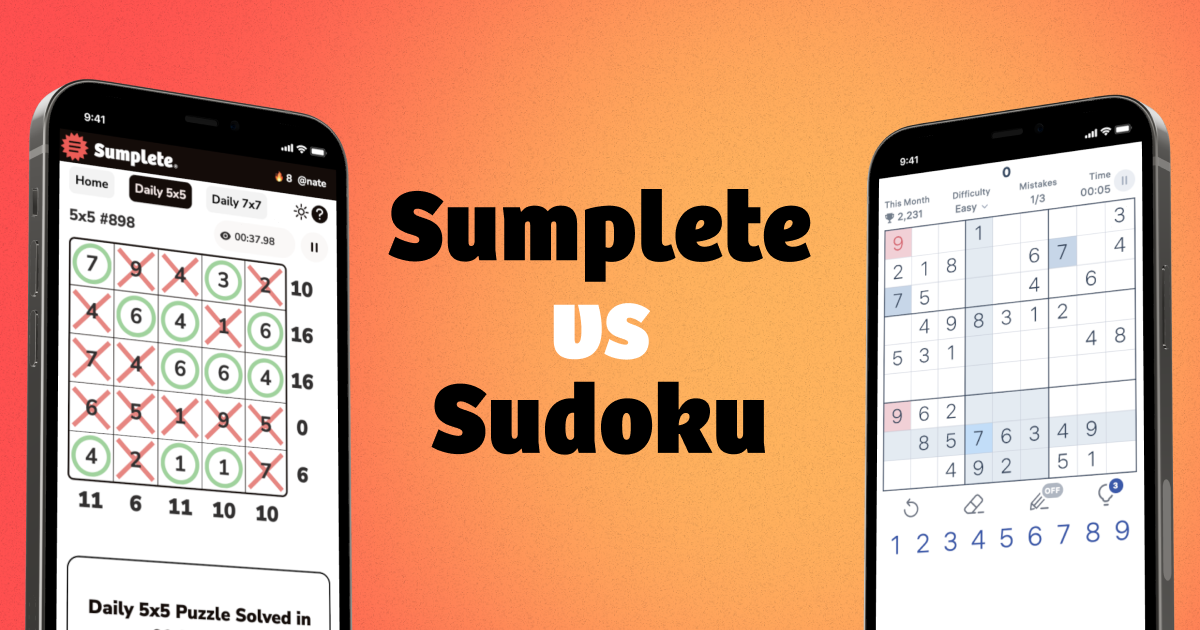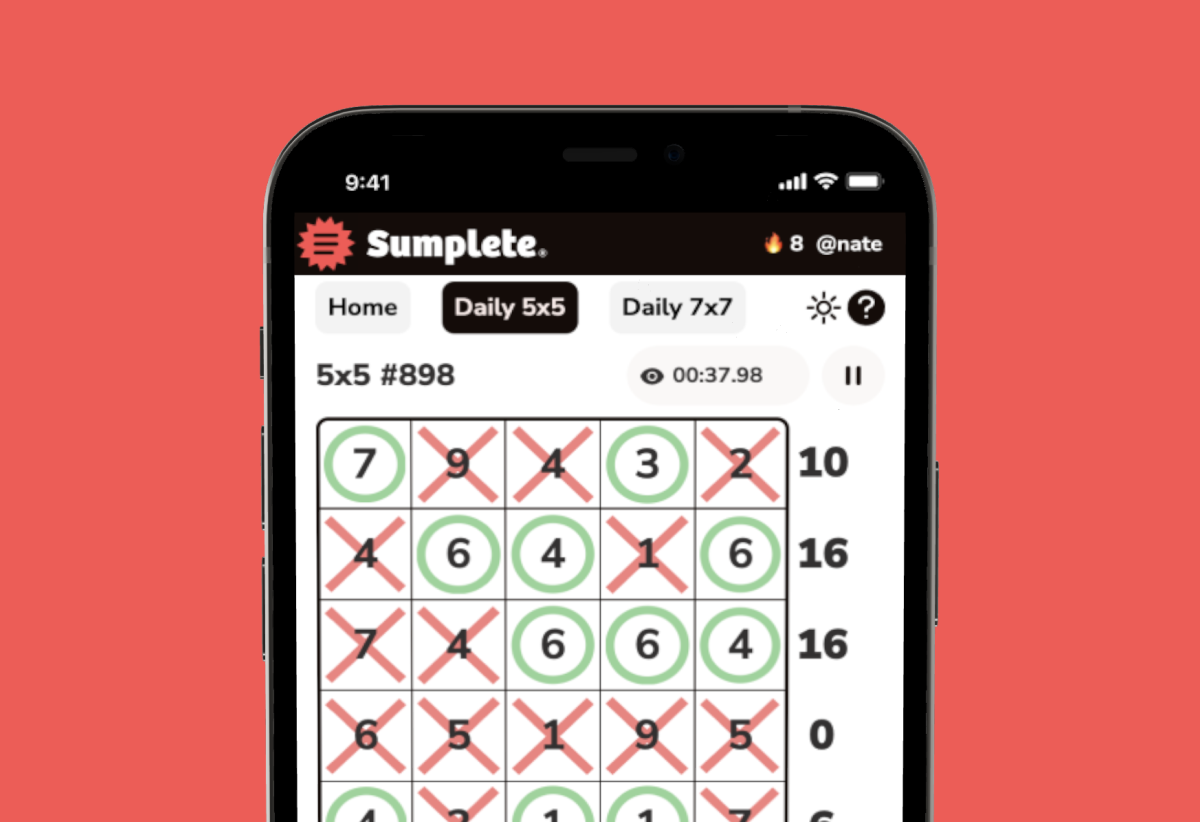Sumplete vs Sudoku: Key Differences & Which Puzzle Fits You

← Back to Daily Number Puzzle Guide
Just kidding. Here’s a little more context:
Sudoku mandates that players use logic to ensure that the numbers 1–9 only appear once in each row, column, and square. Sumplete demands players to use mental math to solve for quick sums on daily 5x5 or 7x7 boards to match each row and column to the corresponding “sum clue” targets.
Both Sudoku and Sumplete are part of a wide range of daily number logic puzzles.
Read on to learn more about each game’s origins, rules, difficulty levels, advanced strategies, and more. At the end, we will make a final decision about which game is best for you. Yes, you!
So stick around — or, jump straight into playing each game using the links below ↓
Play Sumplete Today | Try a Free Sudoku
What is the Origin of Sudoku?

The modern version of Sudoku has roots that date back to a theoretical tool created in the 18th century called the Latin Square. Latin Squares featured grids filled with symbols that would only occur once in each row and column. The symbols ranged from letters and numbers to unique shapes and drawings. The unique sequencing of these symbols was used to solve and aid mathematical research.
The game we know today as Sudoku was published by an anonymous creator in a 1979 edition of Dell Puzzle Magazine, originally under the name “Number Place.” After a couple of decades of international growth, the game really took off in the U.S. at the beginning of the 2000s.
What is the Origin of Sumplete?

Sumplete, on the other hand, made headlines in 2023 for being one of the first number puzzle games to be created with the assistance of ChatGPT. Daniel Tait tested multiple variations of the game through a series of LLM prompts until they arrived at the version that garnered over 50,000 plays just eight days after launch.
Today, Easybrain’s Sudoku mobile app has been downloaded over one million times, while Sumplete averages nearly 30,000 daily plays.
Rules Side-by-Side– How To Lite
| Step | Sudoku | Sumplete |
|---|---|---|
| 1 | Assess the pre-filled cells. Each row, column, and 3×3 box must contain digits 1–9 with no repeats. | Scan each row and column. After eliminations, the remaining cells must equal the fixed target sum for that line. |
| 2 | Pencil in candidates and avoid duplicates as you narrow options with logic. | Cross out cells that would push a row or column past its target. Keep likely cells unmarked. |
| 3 | Use intersections and advanced techniques to place final digits. | Use intersections to zero lines. Select remaining “keep” cells; finish when all targets are met. |
Want to learn Sumplete step by step? Try our how-to guide.
Comparison Table
| Feature | Sudoku | Sumplete | Edge |
|---|---|---|---|
| Grid sizes | 9×9 standard | 5×5, 6×6, 7×7 (Master) | Tie (variety vs familiarity) |
| Avg. solve time | 7–12 min | 3–8 min | Sumplete (quicker) |
| Math required | None (logic only) | Basic addition | Depends on taste |
| Learning curve | Medium (many techniques) | Low (3-step rules) | Sumplete (easier start) |
| Mobile UX | Tight tap targets | Larger cells | Sumplete |
| Community size | Massive (NYT, apps) | Growing niche | Sudoku |
| Brain skills | Pattern recognition | Mental math + deduction | Depends |
What are Sudoku and Sumplete’s Difficulty Levels?
Sudoku and Sumplete offer grids at varying levels of difficulty to suit every type of player.
- Easy: A great level for beginners and those looking to learn the ropes of the game.
- Medium: A step up from “Easy,” but most of the strategies from “Easy” still apply.
- Hard: This mode can be solved with basic strategies, but requires more advanced techniques for those striving to be efficient.
- Expert: Requires advanced strategies to solve the board.
- Master: A step up from “Expert,” and requires advanced strategies to solve the board.
- Extreme (AKA “Evil”): The hardest mode Sudoku has to offer. Requires advanced strategies to solve the board and provides the fewest pre-filled cells out of all of the levels.
Increasing Sumplete’s grid sizes can make the game slightly more challenging with each board expansion. However, Sumplete offers a range of difficulty settings that players can choose from to increase the complexity of the mathematical operations present on the board.
- Easy: All of Sumplete’s grids can be played on the default “Easy” setting. The 3x3 and 4x4 modes are generally easier to solve, as they have fewer cells per board compared to the larger ones.
- Medium: The 6x6, 7x7, 8x8, and 9x9 boards can be played on “Medium.” Generally speaking, the Daily 5x5 grid and the 6x6 board offer a step up from the "Easy" Sumplete experience.
- Hard: The 7x7, 8x8, and 9x9 boards can be played on “Hard.” These boards are the toughest ones to solve due to the higher volumes of cell elimination and selection required to win. For players seeking the toughest grids, check out Sumplete Hard Mode.
- Expert: The 7x7, 8x8, and 9x9 boards can be played on “Expert.”
- Master: Players can only enable the “Master” mode on the 9x9 board.
What are Examples of Sudoku and Sumplete Strategies?
When playing the easier levels of Sudoku, beginners can employ simple strategies such as trial-and-error to solve the board. At the advanced levels, however, many skilled players turn to tactics like the X-wing and Swordfish techniques to progress through the grid.
The former strategy requires the player to identify a single number that can appear in four potential places on the grid, connected via an imaginary “X” on the board. The player must use their deduction skills to solve for the four cells, using their diagonal correspondence to assist with their number eliminations. The latter strategy is an extension of the former. It allows players to expand their pool of possible eliminations, as it extends the pool of potential cells from four to nine.
There are a variety of strategies that Sumplete players can use to reduce their time-to-solve. On the easier levels, strategies such as scanning for 0-sum clues allow the player to quickly eliminate all of the values in a given row or column, as the target value is zero.
At the more advanced levels, players can tally the numbers in a given row or column and subtract the sum from the target clue to identify a “difference clue.” This is the number that the sum of eliminated cells must collectively achieve for the rest of the cells to match the target number. This strategy may not immediately highlight which cells to eliminate, but it can help you rule out certain cells from elimination, as they may be too high or low to be included in the difference clue you achieve.
Which Puzzle Suits Different Players?
- Beginners or Kids: Easy Sudoku boards or games of Sumplete on the 3x3, 4x4, and 5×5 grids are best for puzzle game newcomers and young children.
- Commuters or Casual Players: Those seeking a casual challenge will appreciate a medium-level Sudoku board or a 6×6 Sumplete grid.
- Logic Purists: Logic puzzle enthusiasts should try hard, master, and/or extreme Sudoku boards.
Math Lovers: If you’re great with numbers, boards like the 7x7 Sumplete Master or math-focused games such as KenKen and Kakuro can be quite the test.
Frequently Asked Questions
FAQPage
| Question | Answer (concise) |
|---|---|
| Is Sumplete harder than Sudoku? | Difficulty varies. Sudoku emphasizes pure logic; Sumplete mixes deduction with quick addition. Try 5×5/6×6 for speed, 7×7 for a tougher challenge. |
| Does Sumplete improve math skills? | It can build mental-addition speed and numeric reasoning through repeated short sessions. |
| Can you solve Sudoku with math? | You’ll use logic far more than arithmetic. Some advanced strategies benefit from structured, math-like reasoning. |
| How long to master Sumplete? | Varies by player. Daily play on 5×5/6×6, then 7×7, is the fastest path to mastery. |
Final Verdict
At the end of the day, as long as you are having fun playing a logic or math puzzle game that is testing your abilities, you truly can’t go wrong. But, if you need someone to tell you what to do, here are our recommendations:
If you crave fast wins and mental-math practice, Sumplete is your new daily ritual. Start out with the smaller boards at the easier levels, and progress to the bigger grids while simultaneously cranking up the difficulty settings. If you can beat the 7x7 Expert mode or 9x9 Master in under 5 minutes, call us so our team can hang your username and score in our office’s Hall of Fame (not actually, but if you do accomplish this miraculous feat, let us know @heygoodgames on X).
Do you just love classic grids? Is it your life goal to defeat “Evil” Sudoku boards and protect Gotham from their wrath? Do you go to sleep dreaming about complex X-Wing and Swordfish strategies?
If that’s the case, we recommend keeping Sudoku in your daily rotation to satisfy your craving for deep logic sessions—then come back and test your sums!